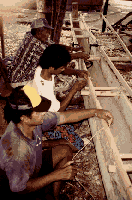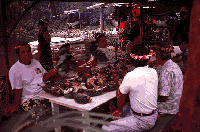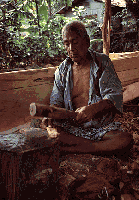Conclusion

 The goal
of this project was to build what was at one time the most sacred
canoe of the Kapingamarangi, the waka sui, to maintain
the knowledge of this ancient art. It was hoped that by having
both the youth and elders of the community working together on
the project the tradition would be passed along. Though I view
this project as a success in many ways, the fact that no one actually
knew how to build this specific canoe caused a forced re-evaluation
of the initial project goals.
The goal
of this project was to build what was at one time the most sacred
canoe of the Kapingamarangi, the waka sui, to maintain
the knowledge of this ancient art. It was hoped that by having
both the youth and elders of the community working together on
the project the tradition would be passed along. Though I view
this project as a success in many ways, the fact that no one actually
knew how to build this specific canoe caused a forced re-evaluation
of the initial project goals.
Had I realized this earlier, perhaps
a more familiar type of Kapinga canoe could have been built. Unfortunately,
this realization came slowly; I continued to believe that the
knowledge to build this canoe of the past would reveal itself.
With the launching, I was finally convinced that the art was no
longer within the collective knowledge of the community. Though
lost from the collective memory, given the quality of construction
and close approximation of the new waka siu to the reports
and photographs of the canoes of the past, I believe the knowledge
can be recovered. The extreme differences in projected capacity
(seven to eight men) and actual capacity (two to three men) clarified
this for me. In short, a waka siu was not built. Given
this, much was still learned. The skills of canoe building were
passed along, albeit incomplete. With the current demand for canoes
almost nonexistent, particularly on Pohnpei, the idea of reintroducing
canoe building seems foolish without an increase in demand.

 Tourism might supply some demand for canoe construction
and use. With the increased interest in eco-tourism, it is conceivable
that a market for canoe tours could be developed. This approach
would also help with the transition toward a cash based economy.
Tourism might supply some demand for canoe construction
and use. With the increased interest in eco-tourism, it is conceivable
that a market for canoe tours could be developed. This approach
would also help with the transition toward a cash based economy.
The value of the canoe, as a means for
supplying food cash free cannot be underestimated. As with other
indigenous practices that have evolved to fit within the natural
environment, the loss of the ability to build and use canoes would
be tragic.

 The goal
of this project was to build what was at one time the most sacred
canoe of the Kapingamarangi, the waka sui, to maintain
the knowledge of this ancient art. It was hoped that by having
both the youth and elders of the community working together on
the project the tradition would be passed along. Though I view
this project as a success in many ways, the fact that no one actually
knew how to build this specific canoe caused a forced re-evaluation
of the initial project goals.
The goal
of this project was to build what was at one time the most sacred
canoe of the Kapingamarangi, the waka sui, to maintain
the knowledge of this ancient art. It was hoped that by having
both the youth and elders of the community working together on
the project the tradition would be passed along. Though I view
this project as a success in many ways, the fact that no one actually
knew how to build this specific canoe caused a forced re-evaluation
of the initial project goals.
